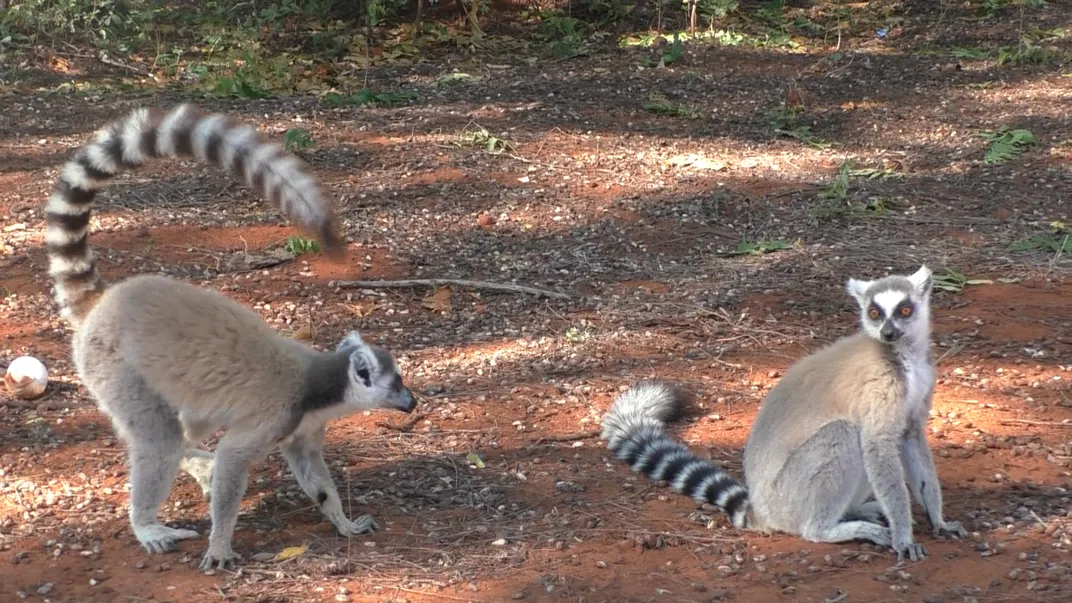For Male Lemurs, Love Stinks—and Scientists Now Know Why
A newly identified trio of chemicals may help the primates find a mate
:focal(804x557:805x558)/https://tf-cmsv2-smithsonianmag-media.s3.amazonaws.com/filer/be/56/be5689f2-2048-4fdd-afcc-5304959c6c76/this_image_shows_a_male_lemur_with_clearly_visible_antebrachial_glands_on_its_wrists_credit_chigusa_tanaka_japan_monkey_centre.png)
A tail doused with floral, fruity cologne appears to be a strong move for male lemurs looking for love, according to new research.
Ring-tailed lemurs (Lemur catta), endangered primates native to Madagascar, engage in what scientists call “stink flirting” during breeding season. To get ready to impress the lady lemurs, males wipe smelly chemicals secreted from glands on their wrists all over their fluffy tails, and then waft their perfumed appendages in the direction of potential mates.
Now, researchers have used chemical analysis to identify a trio of chemicals present in those secretions that appear to pique females’ interest, reports Elizabeth Pennisi for Science.
Outside of the breeding season the male lemurs’ wrist secretions are bitter and leathery, mainly used to tell other males to back off. But when it’s time to mate those scents turn sweet and tropical. The researchers took great pains to collect enough of this breeding season cologne for chemical analysis, using tiny pipettes to gather the miniscule quantities of the liquid before it evaporated.
The analysis revealed three molecules that appeared to be involved in wooing females, the researchers report this week in the journal Current Biology. The smelly triumvirate is made up of the compounds dodecanal, 12-methyltridecanal and tetradecanal all part of a group of well known odorants called aldehydes. One of the aldehydes is known to be an insect sex pheromone and another smells sort of like a pear, according to Science.

Wherever the researchers sprayed the chemicals, females spent some extra time sniffing and even licking the perfumed object, but only during the breeding season and only when all three chemicals were present. The males’ production of this concoction was also tied to their testosterone levels, Touhara and his team note in a statement.
The female response to the spritzings of the chemical mixture suggests it may help males find a mate, according to the researchers, making the ingredients of the lemurs’ chemical cocktail candidates for the first ever pheromones discovered in a primate. But, they add, more evidence is needed before using the term "pheromone" officially.
“We don’t know what happens after the female is interested in this odor,” Kazushige Touhara, biochemist at University of Tokyo and the study’s lead author, tells Max Levy of Massive Science. “So we have to really show that this enhances mating to be able to say that this is definitely a pheromone.”
Broadly defined, pheromones are chemical compounds that transmit signals between individuals of the same species. But the definition has been hotly debated and deciding what is and is not a pheromone can be akin to “drawing a line in the sand,” Christine Drea, an environmental anthropologist at Duke University who was not involved in the study, tells Massive Science.
The clearest examples involve chemicals that prompt physiological changes or an obvious behavior across all members of a species.
Female silk moths, for example, secrete the molecule bombykol, which instantly beckons males as soon as they encounter it, reported Daisy Yuhas in Scientific American in 2014. Other pheromones are slower acting: the molecule alpha-farnesene in male mouse urine has been found to accelerate puberty in young female mice.
Despite droves of armpit sniffing experiments in search of isolating a human love potion, “there is no authentic pheromone that has been chemically identified,” Touhara tells Nicola Davis of the Guardian. But Touhara and his team had good reason to go looking for a potential primate pheromone in lemurs.
Lemurs branched away from humans and the great apes some 60 million years ago and have retained a well-developed sense of smell. They’ve got scent producing glands on their shoulders and genitals in addition to the ones on their wrists, and they deploy their arsenal of odors to start fights, jockey for position in the social hierarchy and, as this new research suggests, seduce mates. They even possess an active version of a scent discerning organ, called the Jacobson’s or vomeronasal organ, that is vestigial in humans and apes.
Massive Science asked Tristram Wyatt, a pheromone expert at the University of Oxford, whether this study’s findings might represent the first recorded primate pheromones. "These are really promising candidates," Wyatt says, "and we’ve not had those before, but what we don’t know at this stage, is that it actually affects anything to do with sex."
Touhara says the responses of female lemurs after smelling the male’s breeding musk are something his team intends to explore in future research. For his part, Touhara tells Massive Science that the lemur love potion smelled “pretty good, actually.”
/https://tf-cmsv2-smithsonianmag-media.s3.amazonaws.com/accounts/headshot/alex.png)


/https://tf-cmsv2-smithsonianmag-media.s3.amazonaws.com/accounts/headshot/alex.png)